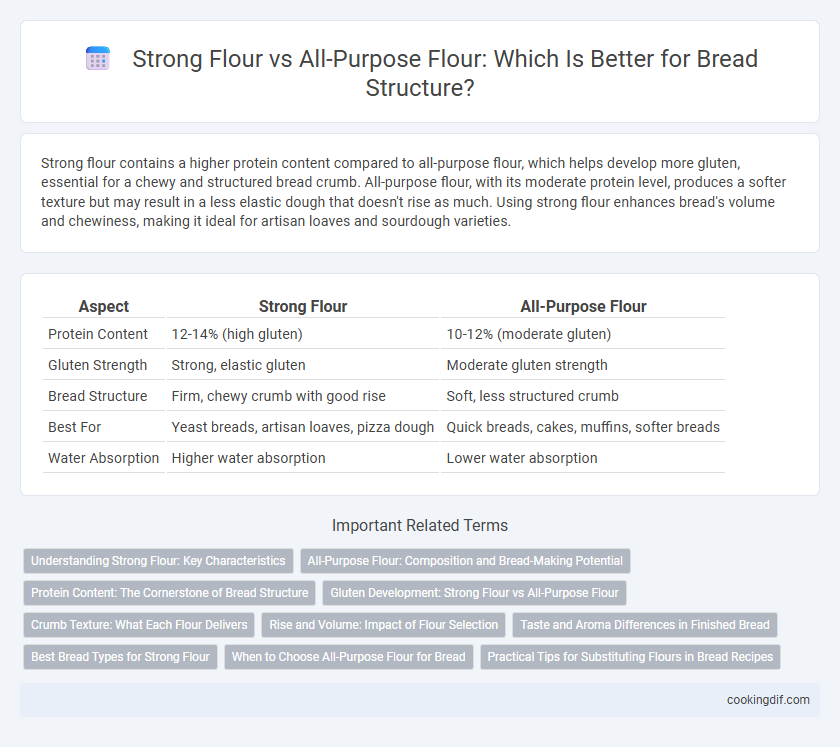Strong flour contains a higher protein content compared to all-purpose flour, which helps develop more gluten, essential for a chewy and structured bread crumb. All-purpose flour, with its moderate protein level, produces a softer texture but may result in a less elastic dough that doesn't rise as much. Using strong flour enhances bread's volume and chewiness, making it ideal for artisan loaves and sourdough varieties.
Table of Comparison
| Aspect | Strong Flour | All-Purpose Flour |
|---|---|---|
| Protein Content | 12-14% (high gluten) | 10-12% (moderate gluten) |
| Gluten Strength | Strong, elastic gluten | Moderate gluten strength |
| Bread Structure | Firm, chewy crumb with good rise | Soft, less structured crumb |
| Best For | Yeast breads, artisan loaves, pizza dough | Quick breads, cakes, muffins, softer breads |
| Water Absorption | Higher water absorption | Lower water absorption |
Understanding Strong Flour: Key Characteristics
Strong flour, also known as bread flour, contains a higher protein content ranging from 12% to 14%, which is essential for developing gluten that provides dough elasticity and structure. This increased gluten formation traps carbon dioxide during fermentation, resulting in a chewier texture and better rise compared to all-purpose flour. Its key characteristics make it ideal for artisan breads, pizza crusts, and any baked goods requiring a firm, airy crumb and robust structural integrity.
All-Purpose Flour: Composition and Bread-Making Potential
All-purpose flour contains a moderate protein content, typically ranging from 10% to 12%, which affects gluten development and bread texture. This composition makes it versatile but less optimal for achieving the strong, elastic gluten network required in artisan bread structure. While suitable for softer breads and everyday baking, all-purpose flour may result in denser loaves compared to strong bread flour with higher protein levels.
Protein Content: The Cornerstone of Bread Structure
Strong flour contains a higher protein content, typically around 12-14%, which is essential for developing gluten networks that provide bread with a robust structure and chewy texture. All-purpose flour usually has a protein content of 10-12%, resulting in a softer crumb and less elastic dough. The elevated protein level in strong flour enhances gas retention during fermentation, contributing to better rise and volume in bread.
Gluten Development: Strong Flour vs All-Purpose Flour
Strong flour contains a higher protein content, usually between 12-14%, which promotes superior gluten development essential for a chewy and well-structured bread crumb. All-purpose flour, with a moderate protein content of around 10-12%, produces less gluten, resulting in a softer, more tender bread with less elasticity. The increased gluten formation in strong flour improves dough strength and gas retention, crucial for artisanal bread varieties like baguettes and sourdough.
Crumb Texture: What Each Flour Delivers
Strong flour contains a higher protein content, typically around 12-14%, which develops more gluten and results in a chewier, more elastic crumb texture ideal for artisan breads and pizzas. All-purpose flour has a moderate protein level of approximately 10-12%, producing a softer crumb with a finer, more tender structure suitable for everyday sandwich and quick breads. The choice between strong and all-purpose flour directly impacts the bread's crumb density, chewiness, and overall structural integrity.
Rise and Volume: Impact of Flour Selection
Strong flour, with its higher protein content typically around 12-14%, develops more gluten, creating a robust dough structure that traps gas effectively, resulting in superior rise and volume in bread. All-purpose flour contains less protein, usually 10-12%, producing a softer dough with less gluten strength, which can lead to a denser crumb and lower loaf volume. Selecting strong flour enhances bread rise and volume, making it the preferred choice for artisanal and rustic bread varieties that require open crumb and substantial height.
Taste and Aroma Differences in Finished Bread
Strong flour, containing higher protein content of around 12-14%, develops more gluten, resulting in a chewier texture and a robust aroma in finished bread. All-purpose flour, with protein levels between 9-12%, produces a softer crumb and a milder, less complex taste. The higher gluten network in strong flour enhances the bread's flavor development through extended fermentation, intensifying the nutty and wheaty notes compared to bread made with all-purpose flour.
Best Bread Types for Strong Flour
Strong flour, with its high protein content typically between 12% and 14%, develops more gluten, providing the elasticity and strength needed for breads like artisan sourdough, bagels, and ciabatta. This flour enhances the rise and chewiness of yeast-leavened breads, making it ideal for recipes requiring a resilient crumb and robust structure. Using strong flour results in a better volume and texture in rustic and crusty bread varieties compared to all-purpose flour.
When to Choose All-Purpose Flour for Bread
All-purpose flour, with a protein content typically between 10-12%, is ideal for softer, less chewy breads such as sandwich loaves and quick breads where a tender crumb is preferred. When making bread types that do not require a strong gluten network, like focaccia or flatbreads, all-purpose flour provides sufficient structure without the toughness of strong flour. Selecting all-purpose flour is beneficial for recipes demanding moderate elasticity and a lighter texture, balancing rise and softness effectively.
Practical Tips for Substituting Flours in Bread Recipes
Strong flour, rich in gluten-forming proteins, enhances bread structure by creating a chewy, elastic crumb ideal for artisanal loaves, while all-purpose flour offers moderate gluten content suitable for softer breads. When substituting all-purpose flour for strong flour, incorporate vital wheat gluten at a ratio of about 1 teaspoon per cup to mimic the protein strength and improve dough elasticity. Adjust hydration levels slightly higher when using all-purpose flour to compensate for its lower absorption capacity, ensuring optimal crumb texture and rise in bread recipes.
Strong Flour vs All-Purpose Flour for bread structure Infographic

 cookingdif.com
cookingdif.com